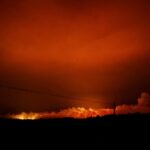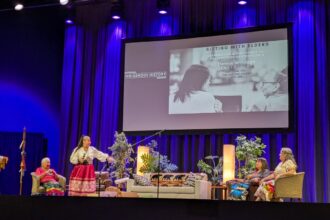In a startling confrontation that underscores the complex relationship between urban living and wildlife, Edmonton resident Robert Barr narrowly escaped serious injury when a protective mother moose charged him in his own backyard last Tuesday morning. The 72-year-old retiree described the encounter as “coming out of nowhere” while he was performing routine yard maintenance at his property backing onto a ravine in Edmonton’s western suburbs.
“I’ve seen moose pass through before, but never this aggressive,” Barr told CO24 News during an exclusive interview. “One minute I was trimming branches, the next I was running for my life with this enormous animal bearing down on me.”
Wildlife officials confirm that the incident occurred during calving season when mother moose are particularly defensive of their young. Security footage from Barr’s home captured the dramatic moment when the 700-pound cow moose lowered her head and charged at approximately 35 km/h, forcing Barr to seek refuge behind a garden shed mere seconds before impact.
“The proximity of residential developments to natural corridors has created an increase in wildlife encounters across Alberta,” explains Dr. Melissa Kumar, wildlife biologist with the University of Alberta. “Moose, in particular, have adapted to urban environments but remain unpredictable, especially females protecting calves.”
Provincial data indicates a 27% increase in reported moose-human interactions within Edmonton city limits over the past five years. This surge correlates with expanding residential development into previously undisturbed wildlife habitats, according to Alberta Fish and Wildlife.
Barr sustained minor bruising during his escape but avoided serious injury. “I’m just grateful I could move fast enough,” he reflected. “My neighbor wasn’t so lucky last year when his dog startled a deer – ended up with a broken arm.”
The incident has sparked renewed discussions about wildlife management in urban areas. City councilor James Hoffman has called for enhanced education programs for residents living near natural corridors. “We need to balance preservation of wildlife habitats with public safety,” Hoffman stated at yesterday’s council meeting. “Many residents don’t recognize warning signs from wildlife or understand how to safely respond.”
Edmonton’s Parks and Recreation Department has responded by announcing increased signage in neighborhoods adjacent to ravines and natural areas, particularly highlighting seasonal risks during calving periods from May through June.
For residents like Barr, the encounter served as a visceral reminder of nature’s unpredictability. “I’ve lived here twenty years and thought I understood the wildlife patterns,” he said. “Now I scan the entire yard before stepping outside.”
Wildlife experts recommend maintaining a minimum distance of 25 meters from moose, recognizing warning signs like laid-back ears or raised hackles, and never positioning yourself between a mother and her calves. If confronted, seeking substantial cover like a building or vehicle offers the best protection.
As urban centers continue expanding into natural habitats across Canada, how will communities balance human safety with the preservation of wildlife corridors that have existed for centuries before our arrival?

























